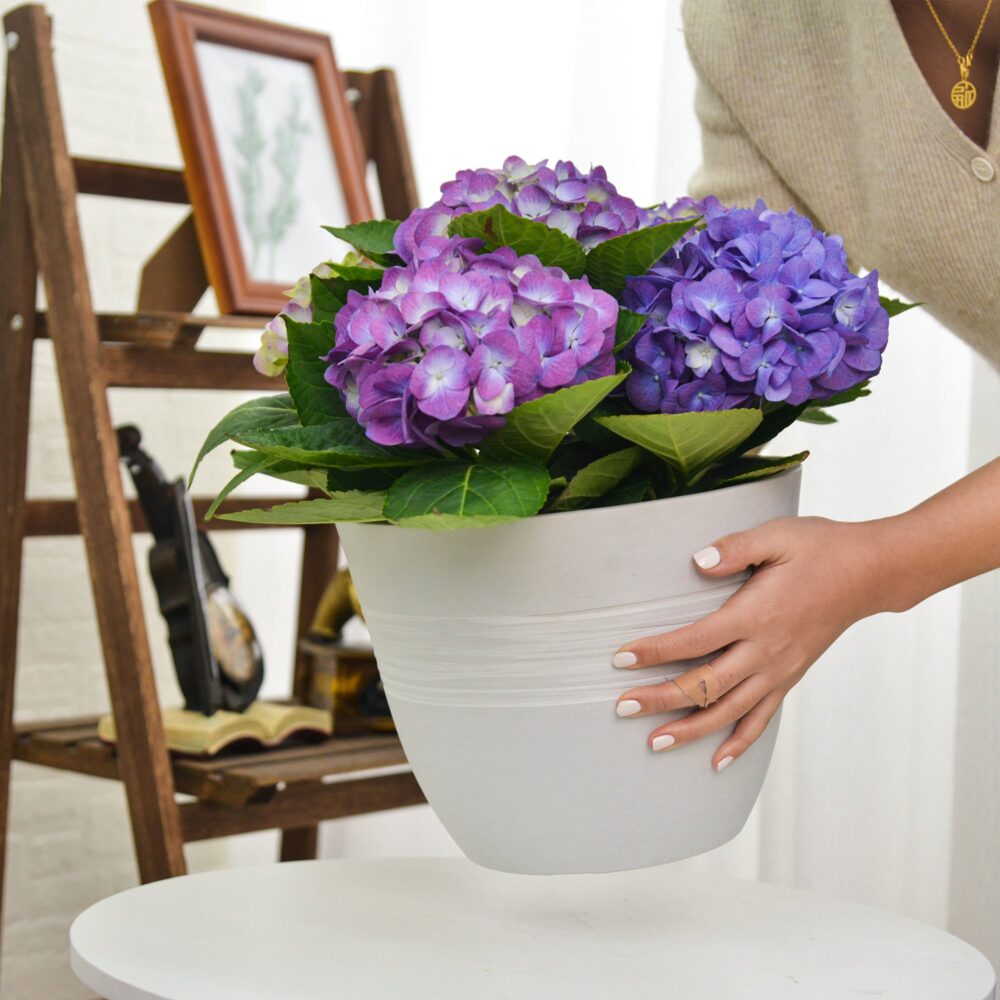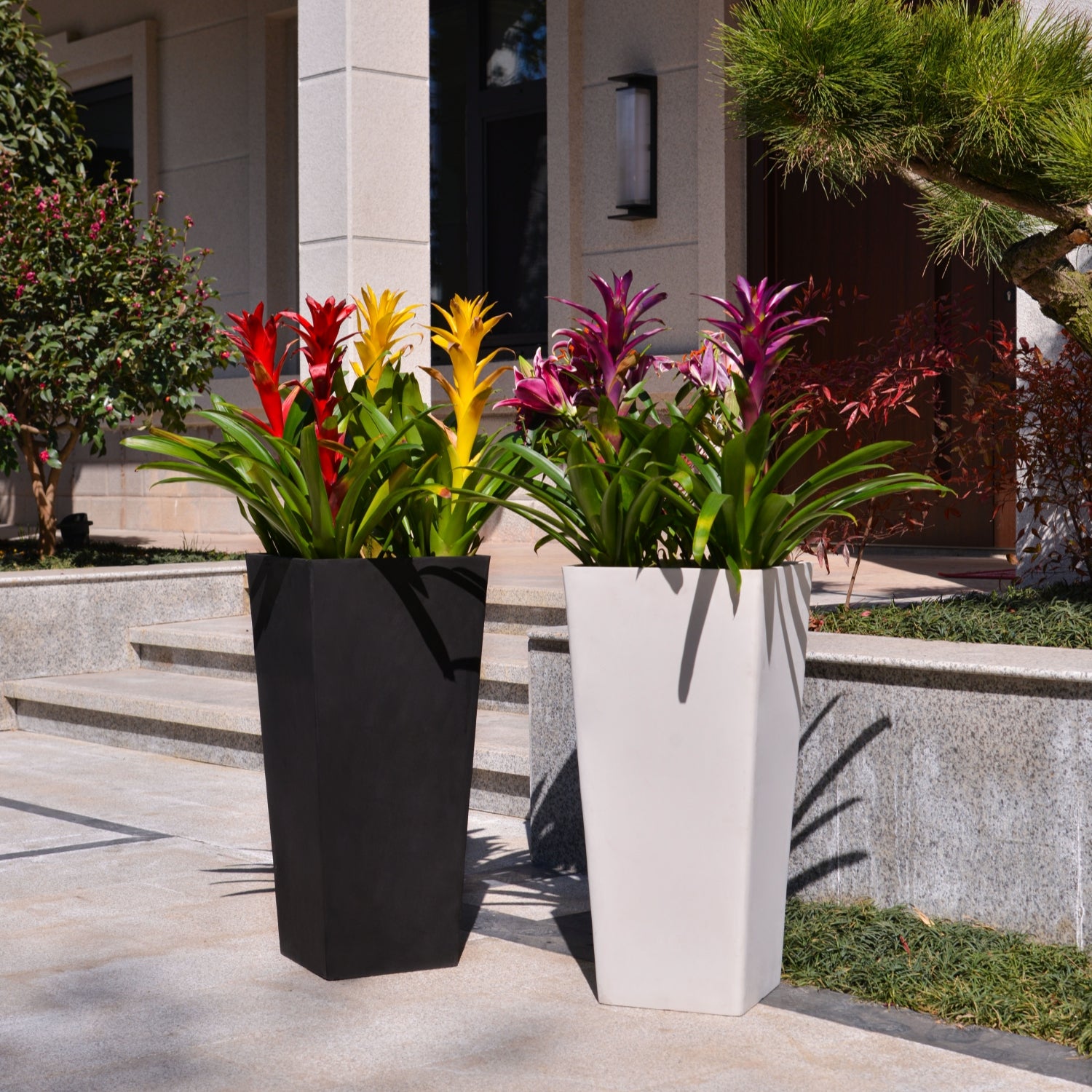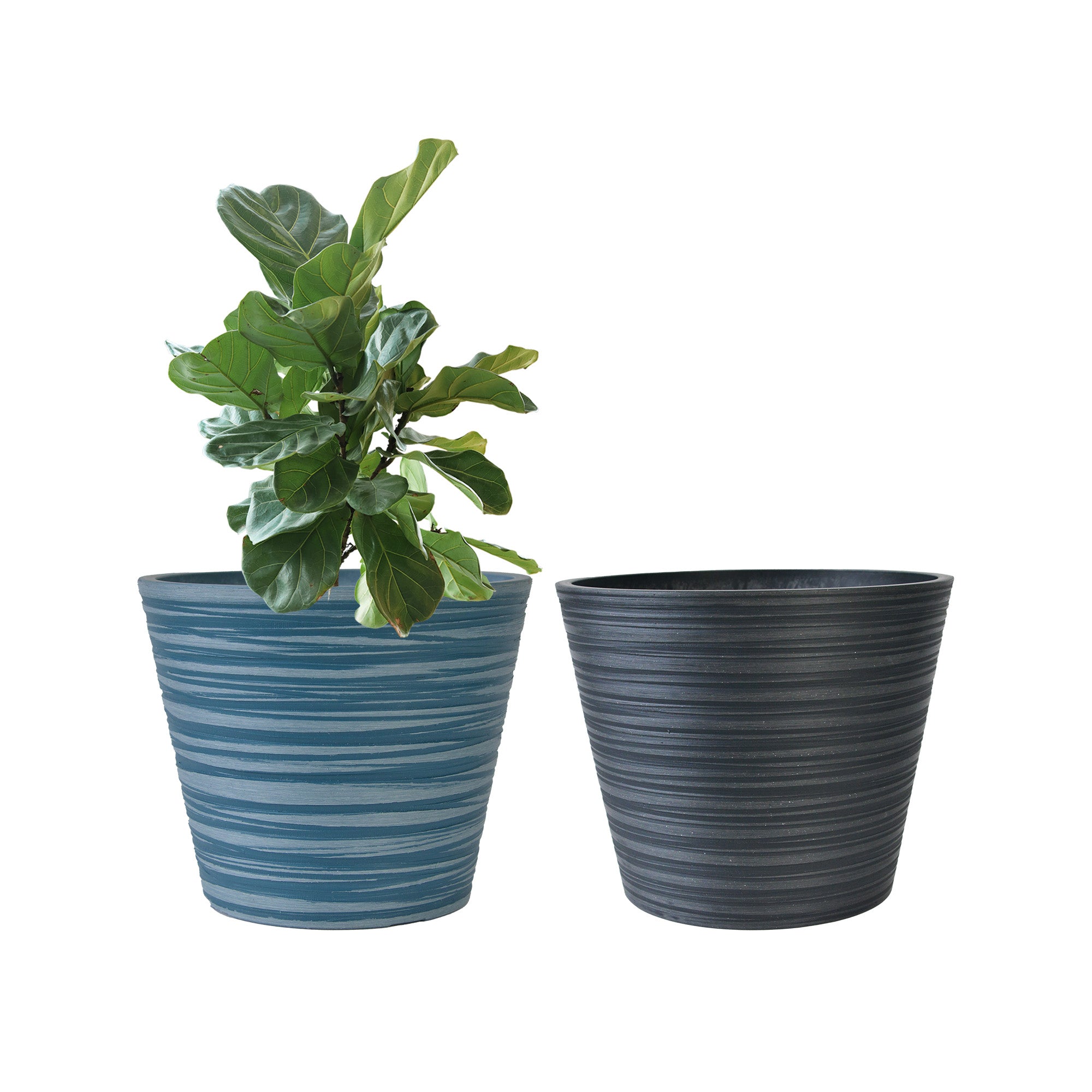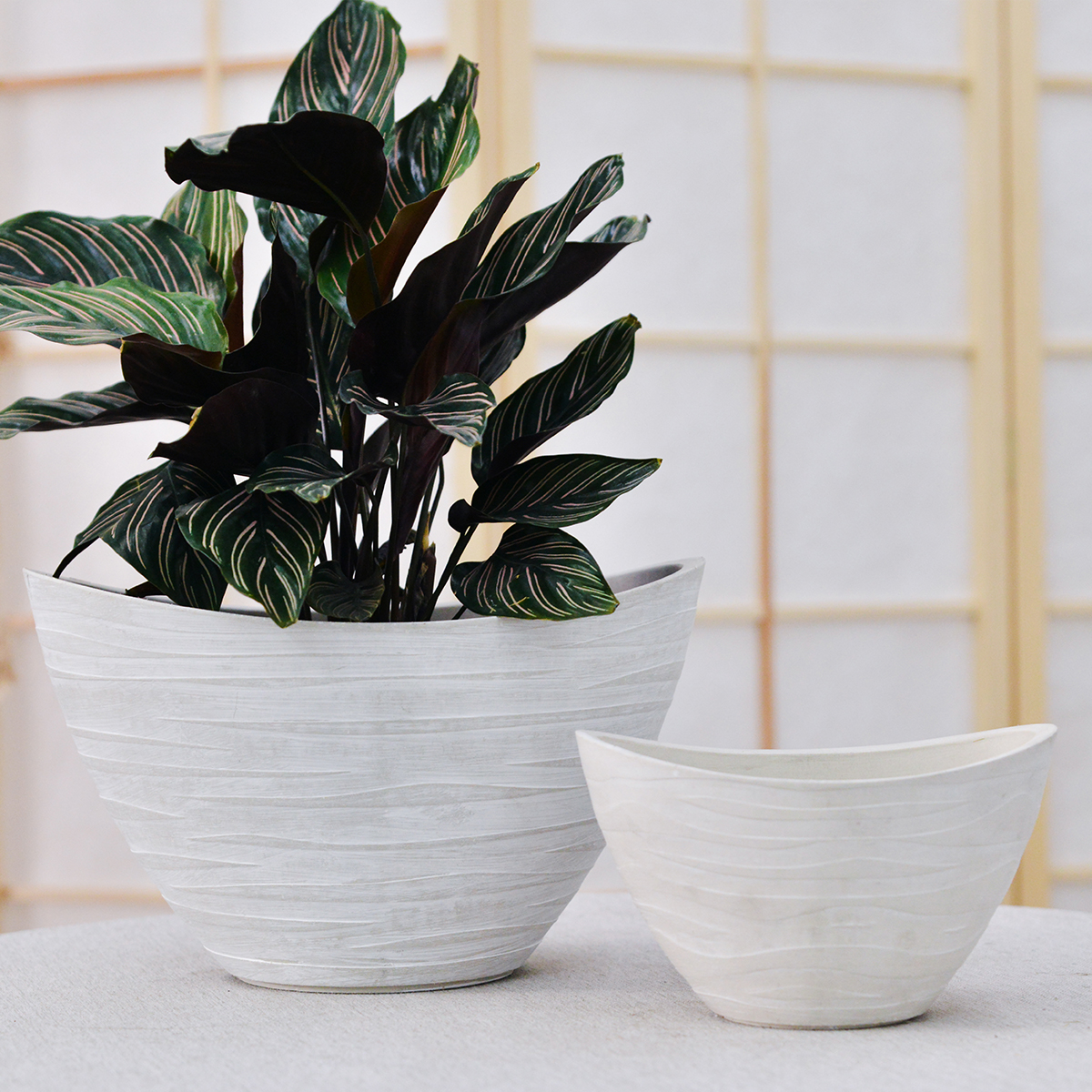Carnations in Pots: The Definitive Guide to Growing Exquisite Carnations Outdoors in Containers
Want to fill your patio, balcony, or garden with ruffled, clove-scented blooms in a dazzling array of colors? Carnations, beloved for their classic beauty and spicy fragrance, are wonderfully rewarding choices for outdoor container gardening. Celebrated for their exquisite fragrance, diverse flower forms from simple to fully double, wide range of colors, and relatively long bloom time, Carnations are perfect for adding a touch of timeless elegance to sunny outdoor spaces. This comprehensive guide will provide you with everything you need to know to grow Carnations successfully in outdoor pots, from selecting the best varieties and containers to mastering essential care techniques for a season filled with Carnation beauty and fragrance.
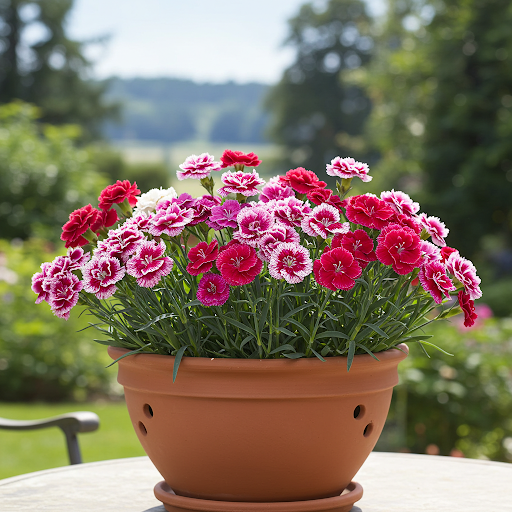
Carnations
What are Carnations?
Carnations, scientifically known as Dianthus caryophyllus, are herbaceous perennial flowering plants belonging to the Caryophyllaceae family (carnation family). Native to Eurasia, Carnations have been cultivated for centuries and are prized for their highly fragrant and often ruffled flowers and long blooming season. Carnation flowers are famous for their intense, spicy-sweet fragrance, often described as clove-like, and their diverse flower forms, ranging from single, semi-double to fully double, often with fringed or ruffled petals. They come in a vast array of colors, including red, pink, purple, lavender, salmon, orange, yellow, white, green, and bi-colors, often with picotee edges, stripes, or contrasting centers. Carnation plants typically exhibit an upright, bushy growth habit, ranging in height from 6 inches to over 3 feet tall, depending on the variety. They are known for their exquisite fragrance, diverse flower forms and colors, relatively long blooming season (spring to fall), sun-loving nature, and excellent cut flower quality, making them an invaluable addition to gardens and containers, especially for adding classic beauty and fragrance.
Are Carnations Good for Outdoor Pots?
Yes, Carnations are exceptionally well-suited for outdoor pots and container gardening. Their upright, compact growth habit, relatively long blooming season, tolerance of sunny locations, and beautiful, fragrant flowers make them ideal for filling pots, window boxes, and mixed container arrangements with classic elegance. Carnations thrive in sunny locations and bloom profusely throughout the warm season, providing a long-lasting and delightful floral display in containers. Their relatively easy-care nature and beautiful, intensely fragrant blooms make them a fantastic and rewarding choice for container gardens of all styles, especially for adding a touch of traditional charm to patios, balconies, and decks. Growing Carnations in pots also allows you to easily move them to optimal locations to best enjoy their fragrance, and to control their growing conditions, especially soil drainage which is crucial for Carnations.
Ideal Growing Conditions for Carnations in Pots:
Types of Carnations for Pots: Many Carnation varieties are excellent for pots, but consider your desired height, bloom time, flower type, and fragrance when choosing:
- Dwarf Carnations: (Dianthus caryophyllus dwarf types) – Compact and smaller in stature, typically under 1 foot tall. Ideal for small pots, miniature gardens, window boxes, and edging. Known for their very compact, bushy habit and profusion of smaller, but still fragrant, flowers. Excellent for creating dense, colorful displays in small containers and for tight spaces. Look for varieties in the ‘ флорадо Series’, ‘ Sunflor Series’, ‘ Picolino Series’, and ‘Oscar Series’.
- Border Carnations (for Pots): (Dianthus caryophyllus border types, dwarf cultivars) – Bushy and more upright than dwarf types, but still relatively compact, typically 1-2 feet tall. Suitable for medium pots, mixed containers, and general garden use. Offer classic carnation flower forms, strong stems, and good fragrance in a manageable size for pots. Look for dwarf border carnation varieties or those specifically labeled for containers.
- Perpetual Flowering Carnations (for Pots): (Dianthus caryophyllus perpetual types, dwarf cultivars) – Bred for exceptionally long blooming season and repeat flowering. Dwarf varieties are well-suited for pots. Look for varieties in the ‘ Dianthus Caryophyllus Perpetual Flowering’, ‘ EverBloom Series’, ‘ флорадо Series’, and ‘ Sunflor Series’. These can bloom almost continuously from spring to fall with regular deadheading and feeding.
- Miniature Carnations: (Dianthus caryophyllus miniature types) – Smaller flower size and compact habit, typically 1-1.5 feet tall. Well-suited for medium pots and mixed containers. Offer a profusion of smaller, but still classic carnation flowers. Look for varieties in the ‘ Мини Series’, ‘ Baby Series’, and other miniature carnation cultivars.
- Novelty Carnations & Hybrids: (Inter-specific hybrids, unique colors, double flowers, picotee edges, patterned petals) – Beyond the classic Carnations, explore modern Dianthus hybrids (often interspecific crosses) that include carnation parentage and offer unique colors, flower forms, and improved performance for containers. Many newer cultivars offer extended bloom times, disease resistance, and novel flower patterns. Look for varieties in the ‘ СуперTrouper Series’, ‘ CONSTANCE Finch’, ‘ Карибский Series’, ‘ Джанет’, ‘ Весна Beauty Series’, and ‘ Wp Dianthus’.
Light: Carnations thrive in full sun. They need at least 6 hours of direct sunlight per day to bloom profusely and maintain vibrant colors and strong stems. Choose a sunny location for your Carnation containers, such as a south-facing patio, balcony, or garden bed. In shady locations, Carnations will produce fewer blooms, become leggy, and may be more susceptible to diseases. Full sun is essential for optimal flowering, intense fragrance, and robust growth.
Soil: Carnations need very well-draining soil that is slightly alkaline to neutral and moderately fertile. Use a high-quality potting mix specifically formulated for containers or flowers. Amend potting mix with perlite, vermiculite, or horticultural grit to improve drainage and aeration, which is crucial for Carnations to prevent root rot. Carnations are very sensitive to soggy soil and prefer soil that dries out somewhat between waterings. Avoid heavy, compacted soil or garden soil in pots, as they can become waterlogged. A slightly alkaline to neutral pH (around 6.5-7.5) is ideal for most Carnations. You can add a little garden lime to your potting mix to raise the pH if needed. Excellent drainage is the most critical factor for successfully growing Carnations in pots.
Watering: Carnations prefer moderately moist to slightly dry soil and are very susceptible to root rot in soggy conditions. Water thoroughly when the top inch of soil feels dry. Water deeply until water drains out of the drainage holes. Allow the soil surface to dry out somewhat between waterings. Avoid overwatering and constantly wet soil. Carnations are more tolerant of underwatering than overwatering. Watering frequency will depend on weather conditions, light levels, pot size, and plant size. During hot, sunny, or windy weather, you may need to water more frequently, especially for young plants and during peak bloom. Check soil moisture regularly and adjust watering accordingly. Water at the base of the plant to keep foliage and flowers dry and help prevent fungal diseases.
Temperature: Carnations are hardy and adaptable plants that tolerate a wide range of temperatures. They are generally cold-hardy perennials in USDA zones 5-9, depending on the variety. They perform best in moderate temperatures between 60°F to 75°F (15°C to 24°C). They can tolerate heat, but prolonged high temperatures above 80°F (27°C) can stress plants and may shorten bloom time, especially for some older varieties. Carnations are frost-hardy and can tolerate light frosts, but protect potted plants from hard freezes, especially in colder zones. Potted Carnations can be overwintered outdoors in most zones, but provide some protection in very cold or exposed locations.
Fertilizer: Carnations are moderate to heavy feeders and benefit from regular fertilization to support their long blooming season and abundant flower production. Fertilize regularly during the growing season (spring to fall) with a balanced liquid fertilizer (e.g., 10-10-10 or 20-20-20) diluted to half strength, every 2-3 weeks. Alternatively, you can use a slow-release granular fertilizer incorporated into the potting mix at planting time, and supplement with liquid fertilizer as needed. Regular fertilization encourages continuous blooming, strong stems, and vibrant flower colors and fragrance. Avoid over-fertilizing, which can lead to leggy growth and weaker stems.
Choosing the Right Pots for Carnations:
Suitable Pot Types: Carnations are adaptable to various pot types, but terracotta and other well-draining pots are highly recommended due to their need for excellent drainage. Consider these factors when selecting pot types for Carnations:
- Terracotta Pots: Porous, allow excellent aeration and drainage, and aesthetically natural and classic. Terracotta is an excellent choice for Carnations as it helps prevent overwatering and promotes good root health, which is crucial for these plants. Terracotta pots also dry out more quickly, which is beneficial for Carnations, helping to avoid soggy soil. Monitor soil moisture and water as needed.
- Unglazed Ceramic Pots: Similar to terracotta, unglazed ceramic pots offer good aeration and drainage. Choose unglazed ceramic over glazed for better breathability.
- Plastic or Resin Pots (with caution): Plastic and resin pots retain moisture much more than terracotta, which can be problematic for Carnations if overwatered. If using plastic or resin pots, ensure excellent drainage holes, and be extra careful with watering, allowing the soil to dry out more between waterings. Amend potting mix aggressively with perlite or grit to improve drainage when using plastic pots. Lighter colored plastic pots may heat up less in direct sun.
- Avoid Deep, Water-Retaining Pots: Carnations prefer shallower pots and dislike constantly wet feet. Avoid very deep pots or pots without drainage holes that can lead to waterlogged soil.
Drainage: Excellent drainage is absolutely essential for Carnations to prevent root rot and ensure healthy growth. Ensure your chosen pot has large and ample drainage holes at the bottom. Avoid pots without drainage holes. Adding a generous layer of drainage material at the base of the pot is highly recommended, such as a 2-3 inch layer of gravel, perlite, horticultural grit, or pot shards to further improve drainage, especially in heavier pots or when using plastic pots. Elevating pots slightly on pot feet or bricks can further improve drainage and air circulation around the base.
Pot Size: Choose pot sizes appropriate for the type and mature size of the Carnation you are planting, and the desired display. Carnation root systems are moderately sized and need adequate space for healthy growth, but do not need excessively large pots.
- Dwarf Carnations: For dwarf Carnations, pots that are 6-8 inches in diameter and at least 6 inches deep are suitable for individual plants. For mass plantings or window boxes, use larger containers or window boxes with spacing of about 6-10 inches between plants.
- Border Carnations & Perpetual Carnations: For Border and Perpetual Flowering Carnations, pots that are 8-12 inches in diameter and at least 8-10 inches deep are suitable for individual plants. For fuller displays or mixed plantings, use pots that are 12-16 inches or larger, or larger tubs.
- Miniature Carnations: For miniature Carnations, pots that are 8-10 inches in diameter and at least 8 inches deep are suitable for individual plants.
Color and Style: Choose pot colors and styles that complement your Carnation blooms and your outdoor décor. Classic or elegant pot styles, such as terracotta urns, glazed ceramic pots, or stone-look containers, enhance the timeless beauty of Carnations. White or pastel-colored pots can create a sophisticated and romantic look, especially for pastel or white Carnation varieties. Boldly colored pots can provide a striking contrast with white, pink, or red Carnations. Terra cotta pots offer a natural, Mediterranean or cottage garden style that complements Carnation’s classic appeal. Consider the overall style of your patio or garden and choose pots that harmonize with the surroundings, and enhance the elegant ambiance you wish to create.
Essential Care Tips for Thriving Carnations in Outdoor Pots:
- Watering: “Water When Top Inch of Soil is Dry, Avoid Overwatering”. Water thoroughly when the top inch of soil feels slightly dry. Water deeply until water drains from drainage holes. Allow soil surface to dry slightly between waterings. Avoid overwatering and soggy soil. Water more frequently during hot, sunny, or windy weather, especially for young plants and during peak bloom. Ensure excellent drainage at all times.
- Sunlight: Provide Full Sun (6+ Hours Daily). Place Carnation pots in a location that receives full sun for best blooming, intense fragrance, and strong stems.
- Fertilizing: Fertilize Regularly, Every 2-3 Weeks During Bloom Season. Fertilize every 2-3 weeks with a dilute balanced liquid fertilizer, or use slow-release fertilizer at planting time and supplement with liquid feed. Regular feeding promotes continuous blooming and vibrant flowers.
- Deadheading (Encourage Continuous Bloom): Deadhead spent or faded flowers regularly to encourage continuous blooming and maintain a tidy appearance. Snip off faded flower heads just below the flower. Regular deadheading is especially important for Perpetual Flowering Carnations to promote repeat blooms.
- Disbudding (For Larger Blooms, Optional): For larger, show-quality blooms, you can disbud Carnations. Remove side buds around the main bud to encourage the central bud to develop into a larger flower. This is optional, but common for exhibition Carnations.
- Staking (For Taller Varieties, Optional): Taller Carnation varieties, especially Border and Perpetual types, may benefit from staking to prevent stems from bending or breaking, especially when blooms are heavy. Use bamboo stakes or plant supports to provide support as needed. Dwarf varieties generally do not need staking.
- Overwintering (Protect from Hard Freezes in Cold Climates): In colder USDA zones where Carnations are hardy, potted Carnations can be overwintered outdoors. Provide some winter protection by mulching heavily around the base of the plants and moving pots to a sheltered location, such as against a south-facing wall or unheated garage, especially in very cold or exposed areas. In extremely cold zones, you may need to insulate pots further by wrapping them in burlap or bubble wrap. Check the hardiness of your specific Carnation variety. Ensure pots are very well-drained to prevent root rot during winter.
- Pest and Disease Control: Carnations are generally relatively pest and disease-resistant, but monitor for occasional pests like aphids, spider mites, thrips, and slugs. Fungal diseases like rust, carnation wilt, and petal blight can occur, especially in humid conditions or with poor air circulation and overwatering. Ensure good air circulation by spacing plants adequately, avoid overcrowding, water at the base of the plant, provide excellent drainage, and avoid overhead watering. Treat any pest or disease issues promptly with insecticidal soap, horticultural oil, neem oil, or appropriate fungicides if necessary. Good drainage and air circulation are key to preventing most Carnation diseases in pots.
Popular Carnation Cultivars for Pots (by Type/Color/Fragrance):
- Dwarf Carnations: ‘ флорадо Pink’ (pink dwarf, compact, floriferous), ‘ Sunflor Orange’ (orange dwarf, ruffled, vibrant), ‘ Picolino Red’ (red dwarf, very compact, early blooming), ‘Oscar White’ (white dwarf, classic form, fragrant), ‘ флорадо White’ (white dwarf, fragrant, compact)
- Border Carnations (for Pots): ‘ Dianthus Caryophyllus ‘ малиновый Glo’ (crimson border carnation, dwarf for pots), ‘ Cottage Pinks ‘Mrs. Sinkins” (white border carnation, heirloom, intensely clove-scented, smaller size), ‘ старый English Pinks ‘Laced Romance’ (pink laced border carnation, fragrant, heirloom, compact varieties), ‘ Antique White’ (white border carnation, fragrant, classic, dwarf types), ‘ Grenadin Red’ (red border carnation, classic form, fragrant, dwarf selections)
- Perpetual Flowering Carnations (for Pots): ‘ EverBloom ‘ гарантия Red’ (red perpetual, long blooming, dwarf), ‘ флорадо Series’ (various perpetual colors, compact, floriferous), ‘ Sunflor Series’ (various perpetual colors, dwarf, ruffled, long blooming), ‘ EverBloom ‘ Пинк Pop’ (bright pink perpetual, dwarf, fragrant, repeat blooming), ‘ непрерывный Summer Series’ (various perpetual colors, heat tolerant)
- Miniature Carnations: ‘ Мини Red’ (red miniature carnation, profuse blooms), ‘ Baby Lace White’ (white miniature carnation, delicate flowers), ‘ Мини Pink’ (pink miniature carnation, compact habit), ‘ Baby Doll Mixed’ (mixed miniature carnations, various colors), ‘ Мини Moon’ (yellow miniature carnation, unique color)
- Novelty Carnations & Hybrids: ‘ СуперTrouper ‘ Strawberry Tart’ (pink and white bi-color, interspecific hybrid, long blooming, good for pots), ‘ CONSTANCE Finch’ (apricot-pink, interspecific hybrid, fragrant, repeat blooming, compact), ‘ Карибский Reef’ (coral-orange, interspecific hybrid, vibrant color, container suitable), ‘ Джанет’ (yellow, unique color, fragrant, good for pots), ‘ Весна Beauty ‘ Черри Vanilla’ (cherry red and white bi-color, early spring blooming, compact), ‘ Wp Dianthus ‘ Карибский Crush’ (orange-red, interspecific hybrid, heat tolerant, container friendly)
- Seed Mixes: ‘Carnation Seed Mix’, ‘Dianthus Seed Mix (Carnation blend)’, ‘Heirloom Carnation Seed Pack’, ‘Cottage Garden Flower Seed Mix (Carnations included)’, ‘Fragrant Flower Seed Mix (Carnations blend)’
In Summary:
Growing Carnations in outdoor pots is a wonderfully rewarding way to add masses of fragrant, ruffled blooms and classic elegance to your patios, balconies, and gardens. Their diverse flower forms and colors, exquisite fragrance, relatively long blooming season, adaptability to sunny locations, and relatively easy-care nature (especially with well-draining soil) make them a perfect choice for container gardeners seeking beautiful, scented plants. By providing full sun, very well-draining potting mix in pots with ample drainage, watering appropriately and avoiding overwatering, fertilizing regularly during the growing season, deadheading spent flowers, and providing minimal care, you can easily cultivate thriving Carnation plants in pots and enjoy their captivating fragrance and charming blooms from spring until fall, year after year for perennial varieties, or as cheerful annuals.
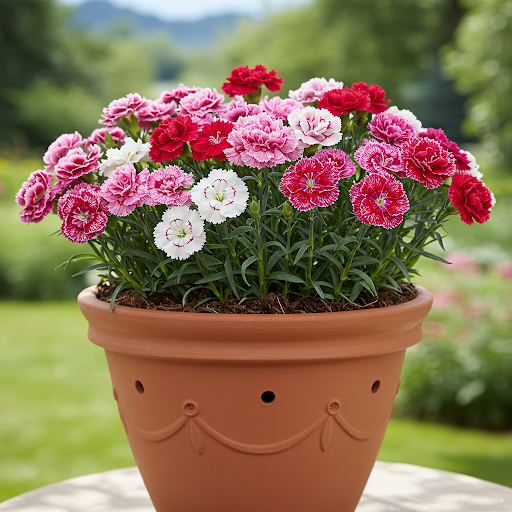
Carnations
For more detailed botanical information and to explore the diverse world of Dianthus caryophyllus cultivars, you can visit the Wikipedia page on Carnations.
Important Note: Carnations are generally considered non-toxic to humans and pets, making them a safe and attractive choice for households with children and animals. The primary care benefits of Carnations in pots are their exceptionally strong and beautiful fragrance, diverse and charming flower forms in a wide range of colors, and relatively long bloom time, bringing classic beauty and delightful scent to your outdoor spaces for many months. With these simple care practices, you can enjoy a season filled with the enchanting beauty and fragrance of Carnations in your outdoor containers.
Planter for Indoor Outdoor Plants, Set of 2 Modern Decorative Plant Pots with Drainage Hole, Decorative Flower Pots
By greenship-seo|2025-01-14T12:26:44+00:00January 14, 2025|Categories: Hand-carving Series|Tags: Decorative Flower Pots|
GreenShip 27inch Tall Planters for Porch, Large Outdoor Planter Pots with Drainage Hole
By greenship-seo|2025-04-10T06:27:21+00:00April 7, 2025|Categories: Hand-carving Series|Tags: Decorative Flower Pots|
Planter 5 in W / 8 in W / 12 in W or Indoor Outdoor Plants, Modern Decorative Plant Pots with Drainage Hole, Decorative Flower Pots
By greenship-seo|2025-04-10T06:37:58+00:00January 16, 2025|Categories: Hand-carving Series|Tags: Decorative Flower Pots|
20YB
By greenship|2024-08-16T05:37:57+00:00August 16, 2024|Categories: Hand-carving Series|
KC3-14A
By greenship|2024-08-16T06:26:30+00:00August 16, 2024|Categories: Hand-carving Series|
11V
By greenship|2024-08-13T03:05:48+00:00August 13, 2024|Categories: Hand-carving Series|

